Shocking but true: Up to 70% of cattle herds in the United States have been exposed to the Bovine Viral Diarrhea Virus (BVDV), showcasing the virus’s pervasive impact on the industry.
This statistic underscores the urgency for robust BVD testing and BVD control protocols within cattle health management. As BVD management practices evolve, the integration of precise Bovine Viral Diarrhea testing and Bovine Viral Diarrhea control methods is more than just advisable; it is critical in safeguarding cattle well-being and ensuring economic stability for producers.
Effective BVD management hinges on employing comprehensive testing and control schemes tailored to address the complex life cycle of the virus.
Our in-depth look into these indispensable components of animal health management begins here—highlighting the strategies, implications, and innovations on the front lines of BVDV mitigation.
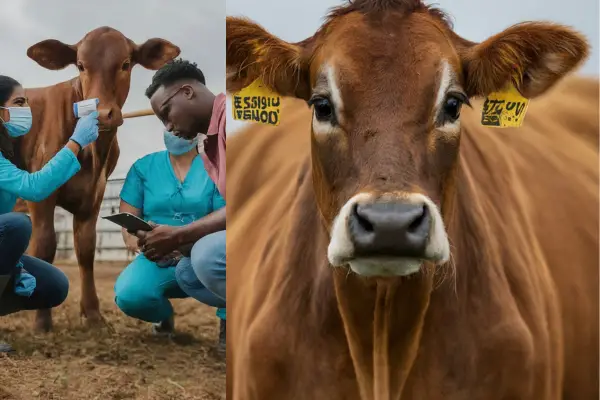
Understanding Bovine Viral Diarrhea Virus in Cattle
The Bovine Viral Diarrhea Virus (BVDV) is a pathogen with complex interactions in its bovine hosts, defining a range of health outcomes based on its virulence and the cattle’s immune response. Let’s delve into the nuanced clinical presentation and the severe implications this virus can have within cattle herds.
The Clinical Signs and Incubation of BVDV
Exposure to BVDV triggers a variable incubation period, typically spanning between three to five days before the emergence of telltale BVDV clinical signs. The severity of these signs largely depends on the immune competence of the individual cattle and the specific strain of the virus they encounter.
The spectrum of clinical observations can include, but is not limited to, fever, diarrhea, and respiratory distress, complicating the diagnosis and management of the afflicted cattle.
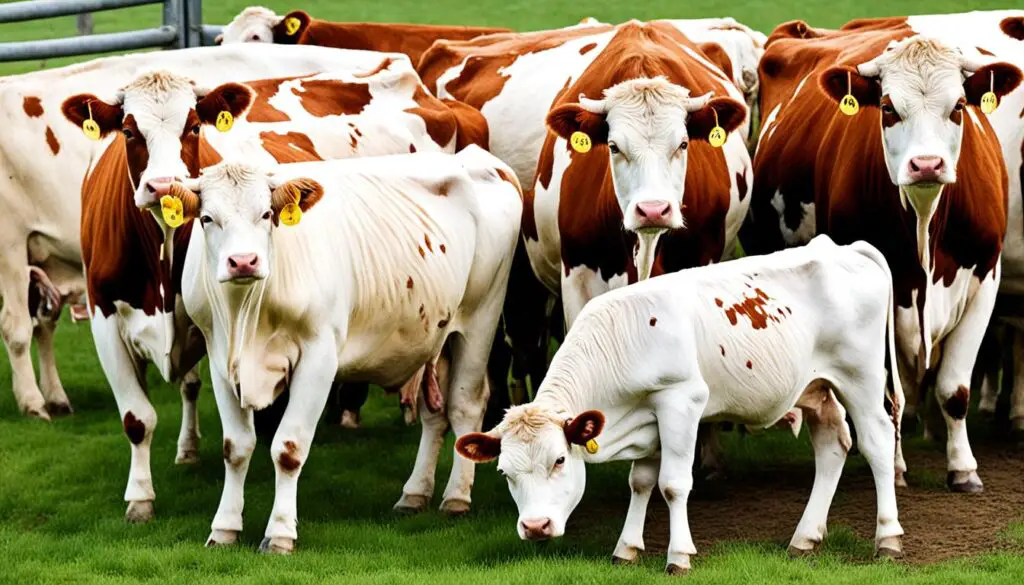
Implications of Acute and Chronic Infections in Herds
An acute BVD infection can be devastating, presenting as severe illness with economic repercussions from decreased productivity and heightened medical costs.
Chronic BVD infection generates a reservoir of infection through persistently infected (PI) carriers—newborns from dams infected during a critical gestation phase. These PI individuals maintain a viral presence within the herd, underscoring the importance of understanding BVDV’s impact on herd health.
| Condition | Clinical Signs | Impact on Herd |
|---|---|---|
| Acute BVD Infection | High fever, bloody diarrhea, ulcers | Increased mortality, decreased milk production |
| Chronic BVD Infection | Milder or subclinical signs | Continued viral shedding, PI carrier development |
Understanding both acute and chronic forms of BVD in cattle is pivotal for implementing effective surveillance and management strategies aimed at mitigating the financial and welfare implications of this pervasive disease.
Assessing the Economic Impact of BVD in the Cattle Industry
The Bovine Viral Diarrhea (BVD) virus remains a salient challenge within the cattle industry due to its vast economic impact. Addressing BVD efficiently is not just about herd health—it’s also about economic sustainability, as this illness directly affects critical aspects of cattle production, from reproduction to milk yield.
Scrutinizing these economic factors reveals the true cost of the disease and underscores the necessity for comprehensive management strategies.

Reproductive Performance and Premature Culling Costs
The fallout from BVD on reproductive performance in cattle herds can be extreme, with a cascade of consequences that extend to the very viability of the herd. Livestock managers grapple with a reduced calving rate, as BVD can lead to infertility, abortions, and other reproductive tribulations.
These adverse outcomes pave the way for premature culling, propelling producers to offload valuable breeding stock earlier than intended, thereby incurring significant losses.
Losses from Milk Production and Growth Declines
Compounding the reproductive repercussions, BVD is culpable for noticeable milk production losses and stunted growth in infected cattle. These aspects are critical revenue streams for producers and when compromised, they represent a direct dent in profitability.
The industry must confront these challenges not only to safeguard animal health but to maintain a competitive edge in an ever-evolving agricultural economy.
| Aspect of Impact | Estimated Loss | Potential Solutions |
|---|---|---|
| Reproductive Efficiency | Decrease by 10-20% | Enhanced BVD management protocols |
| Premature Culling Rate | Increase by up to 5% | Regular health screenings |
| Milk Production | Reduction of 500-1000 lbs per lactation | Adoption of robust vaccination programs |
| Livestock Growth | Weight gain reduced by up to 30% | Early identification and elimination of PI animals |
In conclusion, the BVD economic impact on the cattle industry presents a complex web of challenges that affects every facet of farm economics—from reproductive performance to milk yield and livestock growth.
Tackling BVD with a consortium of proactive measures including diligent management, strategic preventive strategies, and ongoing education remains pivotal in attenuating the financial strain imposed by this pervasive agricultural affliction.
Transmission Pathways and Prevention Measures for BVD
The battle against Bovine Viral Diarrhea (BVD) within the cattle industry hinges on understanding the modes of BVD transmission pathways and implementing effective BVD prevention measures. With the virus capable of both direct BVDV spread and indirect BVDV spread, a comprehensive approach is essential for safeguarding cattle health and preventing economic losses.
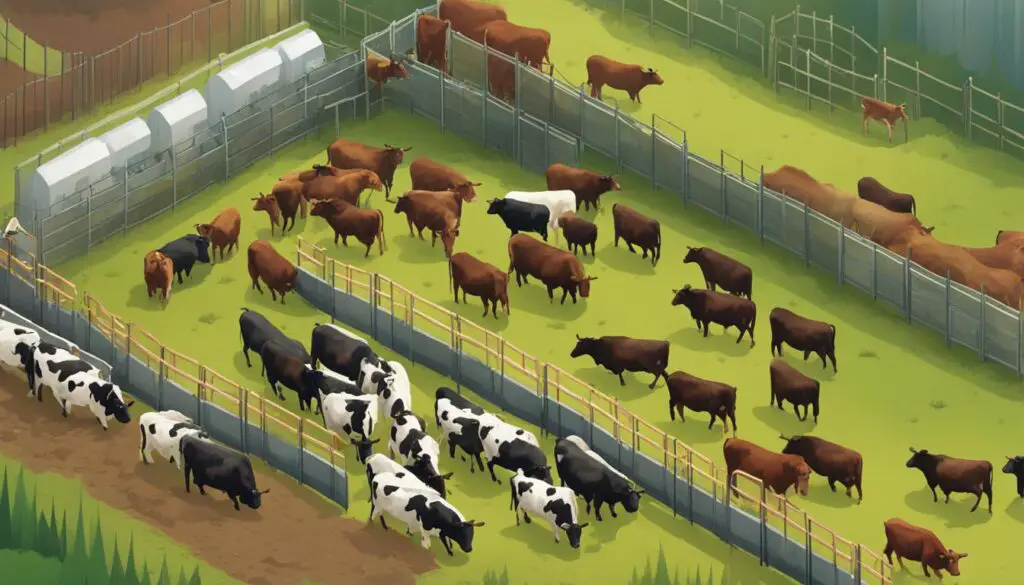
Direct and Indirect Spread of BVD Virus
Transmission through direct contact occurs when susceptible cattle come in close proximity to animals that are either recently infected with BVDV or are persistently infected (PI). These interactions pose a critical risk of viral transmission, emphasizing the need for vigilant herd management.
Conversely, indirect transmission involves the spread of the virus through contaminated objects or environments, such as equipment, feeders, and water sources that are not adequately sanitized.
- Direct spread: Contact with infected or PI animals.
- Indirect spread: Contaminated equipment and shared resources.
The Role of Vaccination in Mitigating Transmission Risks
Vaccination stands as a cornerstone in the repertoire of BVD prevention measures. The use of BVD vaccinations in cattle operations forms an integral layer of defense, significantly reducing the likelihood of transmission. Understanding the strengths of both modified live and killed vaccines can guide producers to make informed decisions tailored to the specific needs of their herds.
| Vaccine Type | Advantages | Considerations |
|---|---|---|
| Modified Live Vaccines | Longer-lasting immunity, robust response | Use with caution in pregnant animals |
| Killed Vaccines | Safer option for use during pregnancy | Shorter duration of immunity, may require boosters |
In addition to vaccinations, rigorous testing for non-carrier status is a proactive measure for preventing the establishment of BVD within populations. Integrating thorough biosecurity protocols, particularly when introducing new animals to the herd, can curb the potential for both direct and indirect BVDV spread.
By harmonizing these strategies, producers can bolster the resilience of their cattle against the pervasive threat of BVD.
Bovine Viral Diarrhea (BVD) Testing and Control Strategies
To secure the health of cattle herds and prevent outbreaks of Bovine Viral Diarrhea (BVD), producers must integrate systematic BVD testing strategies and BVD control methods. This involves a combination of BVD diagnostics for early detection and decisive BVD monitoring to manage disease progression.
A pivotal element in this comprehensive approach is the effective BVD screening, which includes routine laboratory tests of blood samples to ascertain BVDV’s presence within the herd.
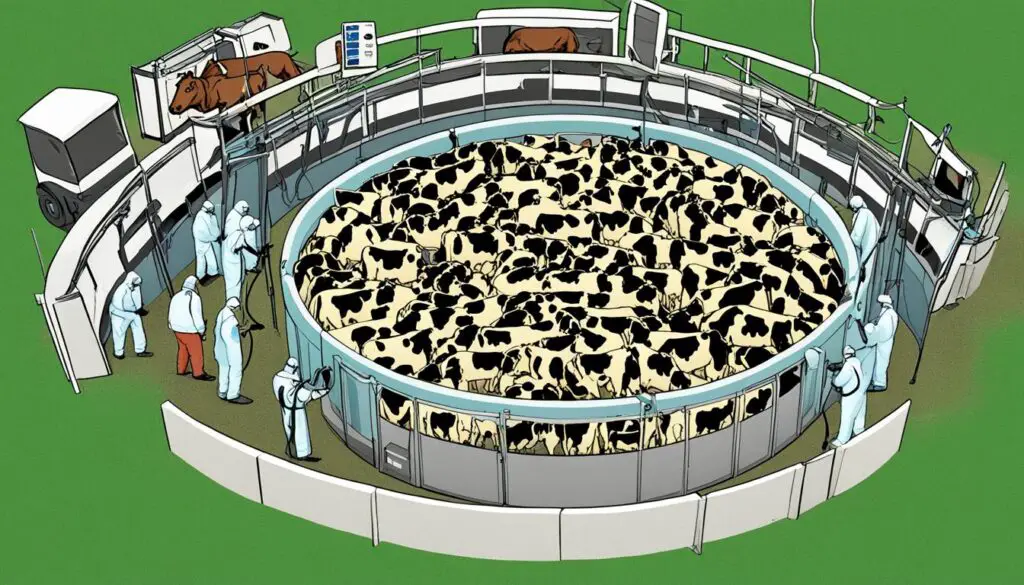
Upon identifying infected animals, immediate action is required, which should focus on both medical intervention and biosecurity. Vaccination programs, another cornerstone of BVD eradication efforts, utilize a combination of modified live vaccines and killed vaccines, tailored to the needs and risks faced by the specific cattle population.
However, the linchpin of disease control arguably lies in the swift identification and removal of persistently infected (PI) carriers, as they serve as a reservoir for BVDV, imperiling the entire herd.
| BVD Diagnostic Method | Sample Type | Typical Use-case | Advantages |
|---|---|---|---|
| PCR (Polymerase Chain Reaction) | Blood/Serum | Identifying active infections | High sensitivity and specificity |
| Antigen-Capture ELISA | Ear-notch skin biopsies | Screening for PI animals | Effective for large-scale screening |
| Virus Isolation | Blood/Serum | Confirming BVDV infections | Gold standard for diagnosis |
| Antibody Detection | Milk/Blood/Serum | Monitoring herd exposure | Can be used for bulk milk sampling |
Integral to the BVD monitoring are biosecurity measures, which must be enforced to curtail virus transmission. These include controlled access to livestock facilities, quarantine zones for new and returning animals, and proper sanitation protocols for both personnel and equipment.
The goal of these comprehensive strategies is not simply to manage BVD, but to steadfastly progress toward its complete eradication.
- Proactive and regular BVD testing of all cattle
- Strategic utilization of vaccines to raise herd immunity
- Isolation and removal of PI animals to break the cycle of infection
- Rigorous biosecurity protocols to prevent the introduction of BVDV
- Educative efforts to inform all stakeholders on BVD risks and prevention
BVD control methods therefore represent a multi-faceted endeavor, demanding engagement from cattle producers, veterinarians, and industry bodies. Such collaboration and steadfast attention to diagnostics and herd management practices are vital in steering the cattle industry towards a future without BVD.
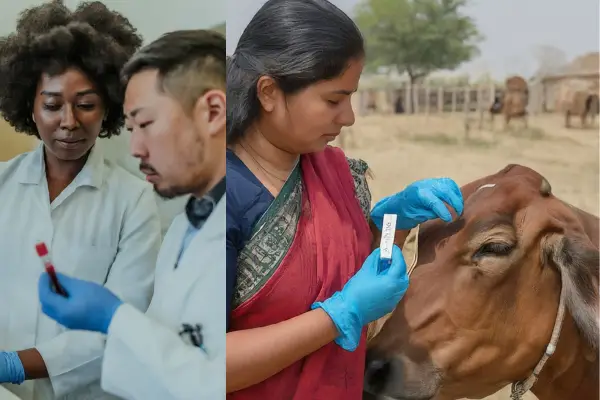
Comprehensive Diagnostic Approaches for Identifying BVD Virus
Ensuring the health of cattle herds necessitates precise identification of Bovine Viral Diarrhea Virus (BVDV). Veterinary professionals use a range of diagnostic tools designed to detect and manage BVDV.
These approaches span from traditional methods such as necropsy examinations to contemporary practices that leverage the accuracy of genetic testing.
Using Necropsy Findings and Laboratory Tests
Necropsy findings provide pivotal insights into the cause of death and can indicate the presence of BVDV, particularly when observable lesions match those characteristic of the virus. Supplementing necropsy data, routine laboratory blood tests further support the diagnosis by identifying antibodies or the presence of the virus itself during acute infections, thereby confirming exposure and informing subsequent control measures.
- Necropsy Findings: Evidence of BVDV in tissue samples.
- Laboratory Blood Tests: Antigen capture ELISA and PCR tests to detect viremia.
Advancements in BVDV Diagnostics: From Blood Tests to DNA Detection
The evolution of BVDV diagnostics has led to the refinement of detection methods. Skin notch assays and polymerase chain reaction (PCR) diagnostics are at the forefront of these advancements. These technologies enable the identification of virus-infected animals before they become symptomatic, facilitating prompt interventions to minimize herd exposure.
| Diagnostic Test | Sample Type | Target | Utility |
|---|---|---|---|
| Antigen Capture ELISA | Blood/Serum | Antigens | Identifies early infection |
| PCR Testing | Blood/Skin notch | BVDV DNA | Confirms PI status |
Ultimately, these diagnostic techniques, with their emphasis on BVDV DNA detection and laboratory blood tests, serve as the cornerstone of contemporary BVDV diagnostic approaches. Through their implementation, cattle health management professionals can execute informed decisions to mitigate the spread of this costly virus.

Best Practices in BVD Management for Cattle Operations
As the agricultural industry continues to advance, BVD management best practices have become a cornerstone for cattle health and productivity. Efficient strategies, which integrate BVDV control in dairy herds and proactive BVD producer education, are fundamental in reducing the prevalence of Bovine Viral Diarrhea Virus (BVDV) and enhancing herd management.
BVDV Control in Dairy Herds and the Significance of Bulk Tank Milk Testing
In the realm of dairy operations, bulk tank milk testing stands out as a pivotal strategy for monitoring and controlling BVDV. This non-invasive testing method provides a valuable snapshot of the herd’s health status, enabling prompt and appropriate interventions.
By routinely analyzing milk samples, producers can detect the presence of BVDV antibodies, thus formulating targeted plans to manage and contain potential outbreaks.
Producer Familiarity with BVD and the Importance of Continuous Education
Empowering producers through comprehensive BVD producer education programs is essential for implementing effective disease management protocols. Continuous learning opportunities allow for the dissemination of the latest research, updates on disease management trends, and shared experiences that collectively enhance producers’ abilities to combat BVD.
Education underscores the significance of vigilance and informed decision-making in the day-to-day management of cattle herds.
- Strengthening understanding of BVDV routes of transmission and prevention
- Highlighting the importance of vaccination and biosecurity measures
- Encouraging regular herd health check-ups and testing routines
Implementing BVD management best practices is a dynamic process that requires persistence, knowledge, and adaptability. When these elements are combined, the cattle industry can look forward to healthier herds and optimized operational productivity.
The Role of Vaccination in a Comprehensive BVD Control Program
Within the framework of a robust Bovine Viral Diarrhea (BVD) control strategy, vaccination stands as a cornerstone, crucial for the reduction of disease transmission and the provision of fetal protection.
The selection of a suitable vaccine type, be it a modified live or killed variant, is determined by a combination of factors, including herd health status, management practices, and the specific needs during various stages of cattle production. Each vaccine type brings specific benefits and limitations to the table, demanding a careful deliberation by producers and veterinarians alike.
Choosing Between Modified Live and Killed BVD Vaccines
Modified live BVD vaccines are known for eliciting a strong and long-lasting immune response. They simulate a natural infection, thereby training the immune system to respond more effectively.
However, their use is advised against in pregnant animals due to safety concerns. In contrast, killed BVD vaccines are considered safer for use during pregnancy and are the preferred choice in this situation, notwithstanding their shorter duration of immunity and potentially less potent stimulation of cellular immunity.
Understanding Vaccine Efficacy and Fetal Protection
The efficacy of BVD vaccines is not absolute, yet they play a pivotal part in protecting the unborn calf, the most vulnerable population to the virus. Despite the challenges associated with complete fetal protection, these vaccines significantly reduce the risk of congenital infections and development of persistently infected calves.
In depth knowledge of vaccine efficacy and maternal antibody dynamics is essential in structuring vaccination programs that maximize BVD fetal protection while curtailing the overall impact of the disease on herd health.
- Modified Live Vaccines – Optimal immune response; use with caution around breeding and pregnant animals
- Killed Vaccines – Safe for pregnant animals; may require booster doses to maintain immunity
Meticulous planning and adaptive vaccination protocols, reflecting the latest research on BVD vaccination role in herd health, will continue to be integral aspects of comprehensive BVD management programs.
With ongoing surveillance and readiness to adjust protocols as new vaccine technologies emerge, the cattle industry can continue to stride toward reducing the prevalence and impact of BVD.
Tackling the Challenge: Eradicating Persistent Infections in Herds
In the fight against Bovine Viral Diarrhea Virus (BVDV), a critical battleground is the eradication of persistent infections that undermine herd health and productivity. The following strategies are pivotal for managing BVDV within cattle populations.
Testing Heifers and Cows for Persistent Infections
Key to controlling BVDV is the meticulous testing of heifers for BVDV and testing cows for BVDV. Early and accurate detection through diagnostic tests, such as ear notch antigen capture ELISA or polymerase chain reaction (PCR) on blood samples, is essential. Finding and identifying persistently infected (PI) individuals is indispensable for eradicating this hidden threat to cattle populations.
Removing PI Animals to Prevent Spread within Herds
Once identified, removing PI cattle from the herd becomes the next critical step. The removal of these carriers is necessary to halt the spread of BVDV, effectively cutting off the virus’s ability to persist and propagate within the herd. This step requires close collaboration with veterinary professionals who can offer guidance on humane and biosecure disposal methods.
The relentless pursuit to eradicate BVDV persistent infections from herds is a challenging yet vital endeavor. It underscores the significance of robust testing protocols and the ethical culling of affected animals in maintaining the health and economic stability of cattle operations across the United States.
Conclusion
As we consider the broad spectrum of Bovine Viral Diarrhea (BVD) management, the integration of comprehensive testing and control mechanisms stands out as pivotal. Producers who effectively integrate BVD testing and control measures play a crucial role in enhancing cattle health management systems.
By adopting these robust protocols, the detrimental effects of BVD can be significantly mitigated, promulgating a ripple effect of benefits across the industry. It is imperative that producer engagement transcends mere application to an understanding of these systems’ intrinsic value for long-term herd health and economic sustainability.
Integrating Testing and Control for Improved Cattle Health Management
In the persistent battle against BVD, an integrated testing and control strategy is not just a preventive measure but a cornerstone of effective cattle health management. Such a multifaceted approach, which includes regular diagnostics, strategic vaccination, and astute biosecurity protocols, is instrumental in circumventing the introduction and spread of BVD within herds. Furthermore, when these strategies are harmonized with current BVD management knowledge, stakeholders can expect a fortified line of defense against this pervasive ailment.
Future Direction of BVD Monitoring and Eradication Efforts
Looking forward with optimism, the future direction of BVD monitoring and eradication efforts is promising. Innovations in veterinary science, enhanced BVD future monitoring systems, and evolving herd management practices are driving forces behind BVD eradication.
Continued advancements in these areas underscore the commitment to diligent disease control. As the industry coalesces around these BVD eradication efforts, we anticipate an era of proactive health management that not only thwarts disease but also fosters a more prosperous cattle industry landscape.


